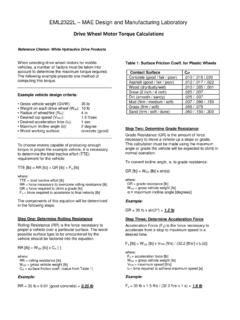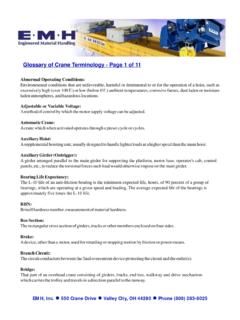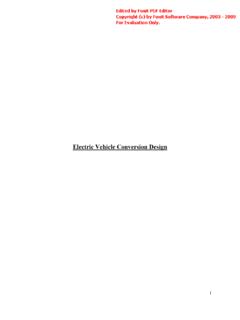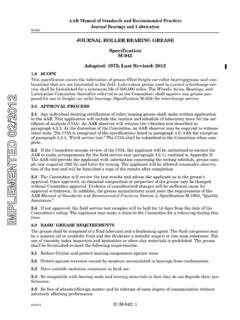Transcription of Pump and Motor Sizing Guide - nestler
1 No. 3-409 January 1998 Eaton Heavy Duty Hydrostatic TransmissionsPump and MotorSizing GuideHeavy Duty Hydrostatic Transmissions2 Heavy Duty Hydrostatic Transmission3 Heavy Duty Hydrostatic TransmissionIntroduction4 Heavy Duty Hydrostatic Transmission5 Heavy Duty Hydrostatic TransmissionIntroduction:Selection of the proper size pump and Motor (s) for your trans-mission application may require one of two methods. The firstmethod is to calculate the Power Range of your vehicle ormachine. This method is used when the final gear reductionbetween the Motor and load is unknown or the customer wantsassistance to select the final drive ratio (see section I). Thesecond method is used when the final drive ratio is specified bythe customer (see section II,2).The following is a list of the commonly encountered vehicle andmachine performance requirements that are specified:1) Tractive effort and vehicle speed in the normal working gearrange.
2 Some vehicles may have 2, 3, or more operating ) Drawbar pull and vehicle speed in the normal working ) Gradeability and vehicle speed in the normal working ) Line pull and line speed for a ) Shaft torque and shaft speed at the output shaft of above factors must all be maximum in value and taken atmaximum applied input Power Range Calculations1. When maximum vehicle tractive effort and maximumvehicle speed in the normal working range are specified,the vehicle power range can be calculated using thefollowing formula: (See Fig. 2a)PRv = (TE)(Vs)/(C1)(Er), where:PRv = Vehicle Power RangeTE = Maximum vehicle tractive effort in the normalworking range (lbs or Newtons)Vs = Maximum vehicle speed in mph or kphC1 = A constant to convert to units of horsepower orKilowattsC1=375 to convert to hp and C1=3600 toconvert to KwEr = Final drive ratio efficiency2.
3 When maximum vehicle drawbar pull and maximumvehicle speed in the working range are specified, thevehicle Power Range can be found from the followingformula:PRv = (DBP+RR)(Vs)/(C1)(Er), where:RR = (r)(GVW)DBP = Maximum vehicle drawbar pull (lbs or New-tons)RR = Vehicle rolling resistance (lbs or Newtons) = Coefficient or rolling resistanceGVW = Gross vehicle weight (lbs or Newtons)Note:Values of r can be found in universally accepted tables ofcoefficients of rolling resistance for various groundcontacting apparatus and ground conditions, such asrubber tires or crawler tracks . See Table 7, page 11 forrepresentative If the maximum vehicle gradeability and maximumvehicle speed in the working range are specified, thevehicle Power Range can be computed from the follow-ing formula: (See Fig. 2b)PRv = (TE)(Vs)/(C1)(Er), where:TE = (GVW)(sin q)+(RR)(cos q)q = Tan-1(G/100) or = Arctan (G/100)TE = Vehicle tractive effort required to ascend thegradeq = Grade Angle (degrees)G = Gradeability (percent)4.
4 If tractive effort, drawbar pull, or gradeability cannot beprovided, the Power Range must be found from knowl-edge of the vehicle operation. Eaton recommends that allvehicle propel applications be sized such that wheel ortrack slip be attainable (exceptions may include an asphaltcompactor or certain personnel carriers). (See )PRV = (TE)(Vs)/C1(Er), where:TE = (Wda)( )TE = Vehicle tractive effort to slip the drive wheels(or track)Wda = Maximum weight on drive wheels (or track) = Coefficient of traction (friction or adhesion)between wheels (or track) and ground (use themaximum value for vehicle operating condi-tions)Note:Values for can be found from universally acceptedtables of coefficients of traction for various types ofground contacting apparatus and ground conditions. SeeTable 8, page 11 for representative If output shaft torque and output shaft speed are known,the Power Range for a machine can be found by thefollowing formula: (See Fig.)
5 1)PRm = (Ts)(Ns)/C2(Er), where:PRm = Machine Power RangeTs = Maximum shaft torque (lb-in or N-m)Ns = Maximum shaft speed (RPM)C2 = A constant to convert to units of = 63025 to convert to HP and 9549,3 toconvert to Duty Hydrostatic TransmissionNote: Be sure to use maximum locked rotor torque whenreplacing electric When line pull and line speed in the normal workingrange are known, the Power Range for a winch applica-tion can be found using the following formula: (See Fig 3)PRw = (LP)(LS)/C3(Er), where:PRw = Winch Power RangeLP = Line pull (lbs or Newtons)LS = Line speed (ft/min or meters/sec)C3 = A constant to convert to units of powerC3 = 33000 to convert to HP and 1000 toconvert to = Final drive ratio efficiencyII. Motor Selection1. The first component selected in a hydrostatic transmis-sion is the Motor . Now select the Eaton heavy dutymotor with a working Power Range rating equal to orgreater than the Power Range calculated for the vehicle,machine, winch, etc.
6 See Table 2 or 5, page 9 or 11 forthe Motor the Motor is to be applied at less than rated speed orpressure, the value used for PR em must be reducedproportionately. If the engine overspeed factor is otherthan the factor used ( ), then the PR em must also bealtered proportionately to adequately account for thecorrect value of engine overspeed. See the formula forPR em for Table 2 or Table 52. If the customer specifies the final drive ratio, select themotor based on the torque necessary to give the desiredtractive effort, drawbar pull, gradeability, shaft torque orwinch drum Calculate the maximum output torque , or winch vehicle propel: Tw = (TE)(LR) Tw = Wheel (ie: axle torque N-m or lb-in)LR = Loaded radius of the drive wheel (inches ormeters) For winch drive : Td = ( )( ) = Cable diameter (inches or mm) N = Number of wraps of the cable on the drum = effective drum radius of the winch (m or in) Td = Winch drum torque (N-m or lb in) = Line (or cable) pull (Newtons or pounds)B.
7 Calculate the necessary Motor torque : For vehicle propel:Tm = Tw/(FDR)(Er), where:Tm = Motor torque necessary to provide maximumvehicle tractive effort, shaft torque or line pull(lb-in or N-m) FDR = Final drive ratioEr = Final drive ratio efficiency For gear box shaft drive : TmTsFDR Er=()() For winch drive : TmTdFDR Er=()()C. Select a Motor having an output torque rating equal to orgreater than the torque calculated in step B above. Seetable 2 or 5 for Motor torque ratings. Select the motorbased on the torque ratings at 414 bar [6000 PSI] unlessa lower pressure must be used based on hose and Final drive Ratio SelectionFinal drive ratios should always be selected based onattaining the vehicle tractive effort, shaft torque or linepull Calculate the maximum drive wheel torque (axle torque )For vehicle propel:Tw = (TE)(LR) For winch drive : Td = ( )( )B.
8 Calculate the maximum hydraulic Motor torque for themotor selected from Section II or listed in table 2 or = (Dm)(P)(Etm)/2 (lb-in)or Tm = (Dm)(P)(Etm)/20 (N-m), where:Tm = Motor torque (lb-in or N-m) D R effD Rd cncd c.. (. )( ..) ()( ..)=++ []517 Heavy Duty Hydrostatic TransmissionDm = Motor displacement (in3/rev or cm3/rev)P = System pressure (bar or PSI)Etm = Motor torque efficiency (use .95)C. Calculate the final drive ratio. For vehicle Propel: FDR = Tw/(Tm)(Er) For gear shaft drive : FDRTsTm Er=()() For winch drive : FDRTdTm Er=()() where: FDR = Final drive ratioNote:Typical final drive efficiencies range from 85 to 90percent. Straight spur gears have an efficiency loss ofapproximately 2% per mesh. Bevel gears have a 7% to12% loss in efficiency per Final drive ratio calculations for multispeed final drivesused for vehicle propel = Tw/(Tm)(Er), where:FDR1 = Final drive ratio in first gearalso K = PRem/HPeand FDR2 = (FDR1)( )/Kand FDR3 = (FDR2)( )/Kand FDR4 = (FDR3)( )/KWhere K = ratio of the Power Range factor of the Eatonmotor selected to normal applied engine :The above multispeed ratio calculations are based onproviding gear ratios that will give uniform increments inoutput torque and output speed.
9 These calculations willprovide a five percent (5%) overlap between successivegear changes. These calculations are only a Guide toassist selecting commercially available multispeed Pump Selection1. Pump selection depends on several factors, includingthe following:A Engine full load governed Maximum engine speed during dynamic brakingconditions will be in excess of the full load speedwhen the engine is back driven by an overrunningload through the Availability of a gear box to increase or decrease thepump speed from the Reversal of pump and Motor identity during periods ofdynamic Determine the Motor speed necessary to provide thespecified output speed. For vehicle propel: Nm = (Vs)(FDR)(m)/LR, where Nm = Necessary loaded Motor speed (RPM) m = Conversion factor to convert to unitsof miles per hour or kilometers per hour m = 168 for MPH and for kph For gear box shaft drive : Nm = (Ns)(FDR) Ns = Output speed of gear box drive shaft For winch drive : NmLS FDR CDR=(.)
10 ()( )(..2 eff)(C ) must be at its minimum value3. Calculate the pump displacement necessary to provide thecalculated Motor = (Ne)(IDR), where:Np = Pump input speed (RPM)Ne = Full load governed engine speed (RPM)IDR = Input drive ratio between pump and engineDp = (Nmn)(Dm)/(Np)(Evp)(Evm), where:Dp = Pump displacement (in3/rev or cm3/rev) Nmn = Necessary loaded Motor speed (RPM)Dm = Motor displacement (in3/rev or cm3/rev)Np = Pump input speed (RPM)Evp = Pump volumetric efficiencyEvm = Motor volumetric efficiencyNote:Pump and Motor volumetric efficiency can be found fromthe performance curves or by using 96% and 97%,respectively, for these efficiency values. Use 94% for avariable displacement If no variation is possible in the input drive ratio to thepump, select the pump with a displacement nearest tothe displacement calculated in part 3 of Section IV.







